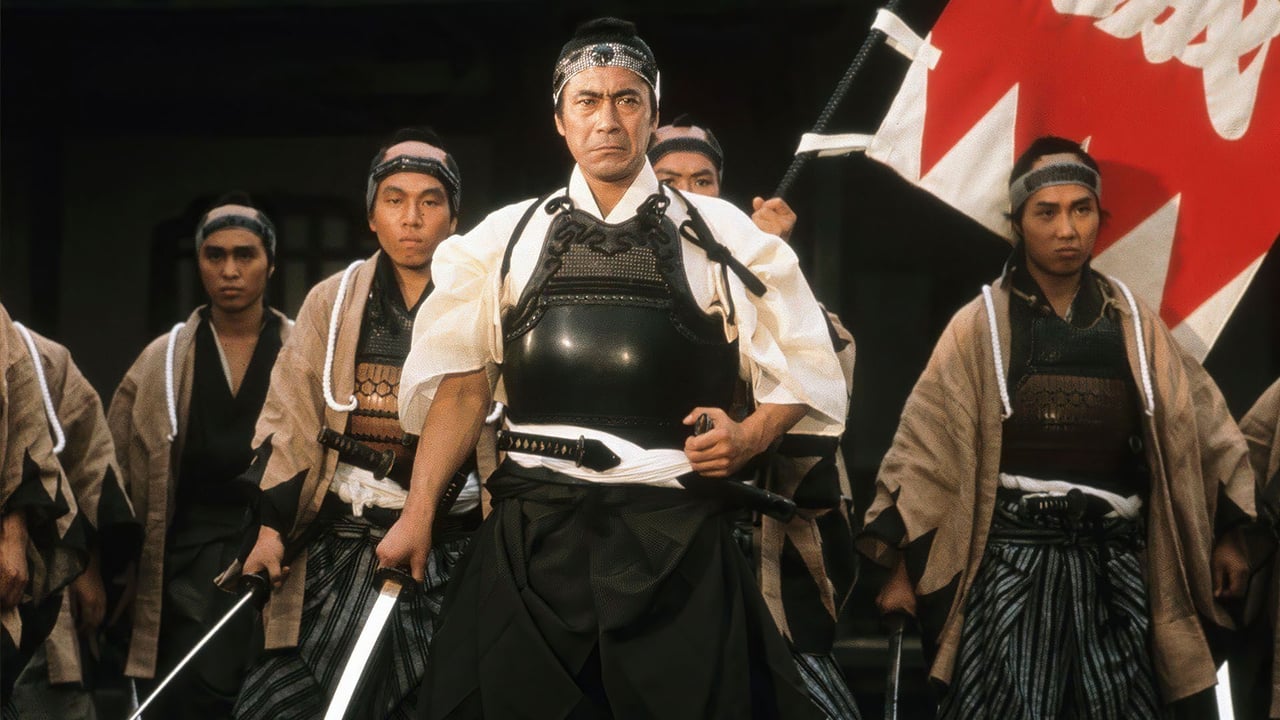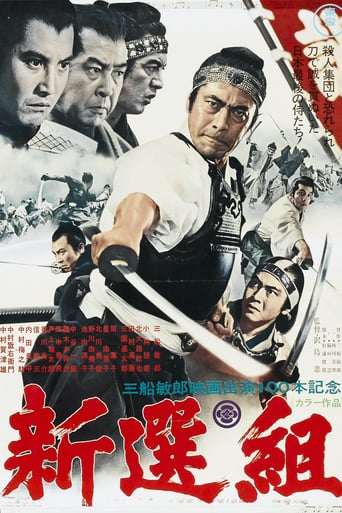

Before I write about the movie, it's important to explain a bit about the DVD. Like some anime shows, this Japanese movie has amazing captioning. When multiple people are talking, the text appears in various colors so it's easy to know who's saying what. But I was especially impressed that while they do a very, very good job translating, like some anime, there are little explanatory notes at the top of the screen that appear to explain what is happening. That way, Westerners who watch this understand the context for what is occurring--at least to a point. I the quality captioning but still think that some, particularly those not acquainted with Japanese history and films, will be a bit confused from time to time (especially which side is which). I know I was--and I am pretty knowledgeable about the history and have seen quite a few other films about this important time period in Japanese history. So, if you see the film, try reading through the program notes in the special features--it helps explain things quite a bit.This film is set during the Meiji period in Japan. During the 1860s, Japan was changing rapidly as a result of the opening of Japan thanks to Admiral Perry's visit in the 1850s. Perry forced the country to open up to foreigners--something that had been banned for about 200 years. But, many in Japan longed for the old ways and a serious struggle ensued--like a civil war. The forces of change supported elevating the true power of the emperor (who had only held ceremonial power for hundreds of years). The traditionalists favored keeping the old ways--the expulsion of all foreigners and supported a strong Shogun (sort of like a "boss" who assumed power through diplomacy, skills and force). In the midst of these struggles, Japanese society was torn apart and chaos ruled the land. This is the background for the film--something the film assumed the audience knew--and if they were Japanese, this is probably true. But, since this is an export film, this background is necessary and was never included in SHINSENGUMI.Into this chaos came the Shinsengumi--a group made up of master-less samurai (ronin) who wanted to restore order in the land. They were traditionalists in many ways (hating foreigners and supporting the Shogun) but they also supported the Emperor--making them sort of like an independent force to ensure the peace. But, to do so, they needed to remain pure in spirit and deed as well as obey orders without question. This complete obedience is a theme throughout the film and several times their oath is put to the test, as followers were expected to kill themselves by committing ritual seppuku if they broke their oath.The leader, at least initially, of the group was a man who had a drinking problem and brought reproach on the group. And, since he would not kill himself (since he was a selfish jerk) the group took action on their own. The film never made this clear who killed the leader, but I did some reading and found out that Kondō Isami (Mifune's character) ordered this killing in order to purify the group from such corruption. Now, the leadership mantle was passed to Isami character--who was pretty much the type guy you'd expect him to be, since he had a long track record in starring in Samurai epics. He's tough, obedient and self-sacrificing--like he expected the rest of the Shinsengumi to be.The film is unusual because it varies so much in mood and pace. Much of the time, the film is rather calm and talkative, but then at others it quickly becomes brutal and violent (the code of the shinsengumi required this)--with some amazingly bloody scenes for 1969. Be prepared to see geysers of blood, severed limbs and the like--which makes since, as they're fighting with swords! In addition, it's unusual in its fatalism--making the film a bit of a downer to watch. If you are looking for a "happily ever after film", you can't get any more unlike it with this film!! I liked the film, though did find it a bit long and in need of even more explanatory notes! Or, perhaps, I should brush up on my Meiji history a bit more--which is what some viewers might want to do before seeing the film.By the way, when I looked up this exceptional DVD on Amazon, it was only $5.99--an awfully good price when you consider the quality of the packaging that goes along with the movie.
... View MoreProduced by Mifune's production company with Hiroshi Inagaki supervising proceedings (in a kind of movie he could make with eyes closed), SHINSENGUMI is a typical, big-budget retelling of a classic Japanese story, but one which, unlike Chusingura, has significantly more relevance to contemporary history and the western world. A sprawling two-hour historical drama, ably, at times even impressively, directed, well acted (Toshiro Mifune practically guarantees that), with an emphasis on the political machinations between Loyalists and Shogunate supporters rather than swordplay, but still broken with sudden bursts of messy violence and bookended with blood spraying on the camera, SHINSENGUMI should be an essential viewing to all lovers of jidaigeki. Possibly even the definitive version of the story.
... View More... a couple of slight historical corrections to previous reviews are in order. Firstly, although the Roshigumi (Ronin Corps) were formed to protect the Shogun during a journey to Kyoto to discuss recent political divisions with the Emperor, when they arrived at Kyoto their leader revealed that he actually wanted to take the Imperial side rather than the Shogunate side. This is why Kondo and the others split and formed the Shinsengumi (Newly Selected Corps). Secondly, although Kondo and some of the others were former farmers, they were all expert swordsmen. Kondo himself had been adopted into a samurai family and was headmaster of the Shieikan Dojo which taught Tennen Rishin style swordsmanship and several of his high ranking students and instructors had joined him in the Roshigumi and Shinsengumi. One in particular, Okita Soji is universally recognised as a "genius swordsman".Other than that I completely agree with the other reviews - this is a film well worth watching!
... View MoreThe year is 1863 and Japan is in a severe political upheaval. The Shogunate of the Tokugawa was fighting the murderous ideology of sonnō jōi: "Revere the Emperor, Expel the Barbarians", whose followers had began to commit acts of murder in Kyoto. In response to this, the Shogan formed the Rōshigumi; a group of 234 Ronin who were to protect the Shogan from harm.One of the leaders of this group was a man named Kondo Isami (Mifune), a man who would eventually dissent and go on to form the Shinsengumi. The former group, the Rōshigumi, became suspicious of the Shinsengumi and sent spies to infiltrate the organization. Henceforth the Shinsengumi not only had to deal with the task of protecting the Shogun, but also with treachery within their own group. This is the setting of Shinsengumi: Assassins of Honor, a carefully researched and violent historical piece set in 19th century Japan.Shinsengumi is an incredibly complex film. I must caution viewers that they might want to read up on the history of the time period before watching this film, if you choose not to, you might have problems following the plot. That being said, as complex as it is, Shinsengumi is just as good and rewarding.To be honest, I knew from the first shot of this film that it was going to be great. The opening shot is of a westerner being slain by a samurai, a torrential downpour of blood spraying into the camera. I have to say the first shot set my expectations high and I wasn't disappointed. After the bloody opener, the film slows down and sets up the highly intricate plot and then introduces the viewer to Isami (expertly played by Toshiro Mifune...as always).Isami is a former farmer and a ronin, who helps form the Shensengumi. After the current leader goes crazy from alcoholism, Isami slays him and becomes the head of the Shinsengumi. Once in power, Isami's finds out his troubles are just beginning.Personally, I don't think I've ever seen a bad performance by the late Toshiro Mifune and Shinsengumi is another testament to his great acting ability. As far as acting goes, Shinsengumi features a great acting ensemble; from Mifune down to Katsuo Nakamura's tragic portrayal of the clan's accountant.The only thing more exquisite than the acting is the wonderful detail poured into the set and wardrobe. Vivid colorful kimonos, haori's and hakam's abound contrasted with beautifully reconstructed 19th century Kyoto; add Kazuo Yamada's expert cinematography and Hiroshi Ueda's capable art direction and you have a historical epic.To be clear, Shinsengumi is not an action film. Although it contains it's share of action (the scene in the Ikeda mercantile factory is incredible!!!)it's primary focus is on character development and an objective look at the political and social problems of late 19th century Japan.Bottom Line-Director Tadashi Sawashima delivers a violent samurai masterpiece, with great acting, score, cinematography, and a flawless Mifune.
... View More